By Anne Indergaard, Annwn Welsh Corgis, Norway
When the first standard was written, it was only natural that it said, "tail short, preferably natural" as a greater percentage of all pems at the time were born with natural short tails. Just look at the photos of the first greats, tail length varied from terrier tails to normal, short bobs, like you can see in Ch. Rozavel Red Dragon, whose tail is very much like the undocked bobs we normally see here today. In her book, The Welsh Corgi Thelma Gray writes, "Many Pembrokes are born tailless or with a very short stump, though half, three-quarter and full length tails are usual." (Third Edition, page 41).

Ch. Rozavel Red Dragon
Where did this trait get lost, then? An old breeder I spoke to about this, told me that when she got a bobtail in a litter, she stopped breeding from that bitch, as the bobs were so difficult to dock, and she found the docked behind so much neater. The same applied to all her friends in corgis. And we all know how easy it is to lose a dominant gene. This means that mostly the gene "survived" where appearance was not the main thing - that is where the pem was kept as a working dog or merely a pet - although the occasional bob slipped through the breeding program in the bigger kennels as well. Stormerbanks used to get some, and in later years Peggy Gamble of the Blands Pembroke took a great interest in them and made sure the gene was preserved.
Natural bobtails
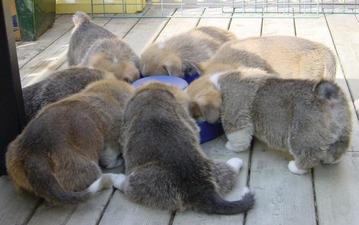
Litter with bob and long tails, Norway |
|
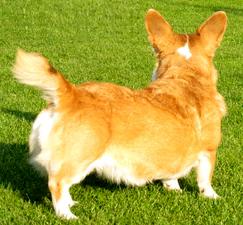
Semi-long tail, Germany |
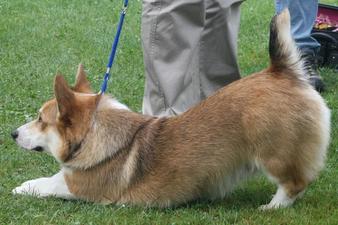
Terrier-like bob, UK Exp. |
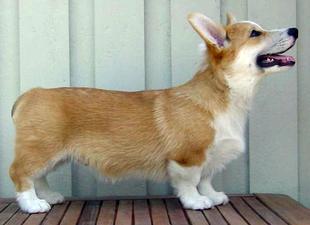
Short bob (long x bob), Norway |
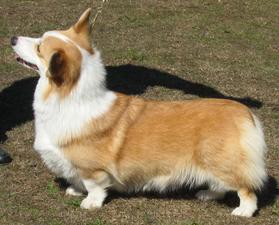 Short bob (long x bob), Norway |
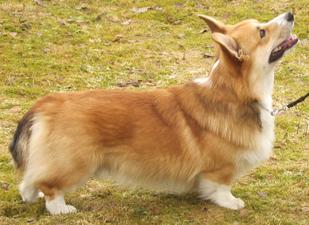
Bobtail (bob x bob), Norway |
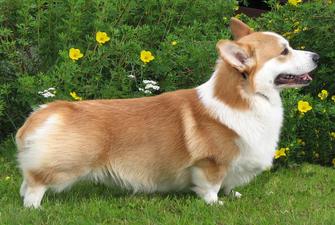
Short bob (bob x bob), Norway |
When the docking ban was enforced in Scandinavia in the late 1980's, the corgi clubs in the Nordic countries all had a different approach to the problem. In Norway, we opted for the natural short tail that is preferred in the standard. As we do not have the big kennels with large breeding stock, it was important that all breeders in the club pulled together and used our resources to the best of the breed.
We turned to Peggy Gamble for help and several stud dogs and brood bitches with natural bobs were imported. These dogs were not of the quality our dogs then had, but we knew we had to sacrifice some generations in order to get what we wanted - the saucy little behind we were used to.
We realised that by breeding only from those few imports, our gene pool would be drastically depleted, so the long tails were looked upon as a gene bank for future generations, while the bobs were bred to our best dogs and bitches, later on breeding the resulting bobs to dogs with full tails again, but still getting over 50% of the pups with short tails.
Nothing much was known about the gene at the time we started. It was assumed it was a dominant gene with incomplete penetrance, and we also assumed that the Welsh farmers of old would certainly not have opted for a dog with a natural bobtail unless this meant it was sound and functional, which was the main thing for a working farm dog. But rumours were aplenty; the bobtail lead to lacking angulation in knee and hock, the bobtail caused kinky tails, the bobtail was related to defects in the spinal vertebrae, the bobtail lead to puppies being born without anus, but worst of all: the bobtail gene was lethal, causing litter sizes to go down, dogs to die an early death or if they survived, they were sickly, poor doers.
Of course the first generation of bobs were lacking in angulation behind, but that was not because of the bob, it was because our first imports were not show specimens, but solely brought into the breeding program for one reason and never line bred to. Bred to well-constructed dogs or bitches, some of the pups with short tails would inherit the construction of the sire, some of the dam, as in all breeding.
Some of the allegations were too far fetched to be taken seriously, others we decided to fight back not with opinions, but with facts. In this we enlisted the help of the Norwegian Kennel Club, Norwegian Veterinary Institute and the Norwegian University's Department of Agriculture, the Corgi Club and the Kennel Club contributing the money, the others their time and knowledge.
First, both pems with natural short tails, docked pems and also those with long tails from all lines in a number considered enough for the study to be relevant, were x-rayed and their vertebrae studied. The studies were conducted by Dr. Astrid Indreboe at the Norwegian Veterinary Institute and have been published in veterinary journals as well as in our own newsletter. Her findings were conclusive; there are no signs whatsoever that the gene for a natural short tail leads to any defects in the spinal vertebrae, nor is it connected with the kinky tail that can be found in both short and long tails.
The claim that bobtail breeding leads to a decrease in litter size was easily repudiated by statistics kept by the club. In fact, the first generation of bobtail breeding gave us larger litters, this probably because they were all complete outcrosses. Now the average litter size is back to normal. Also, the statistics show that no more bobtails were lost in birth or died early than other pups.
Dr. Frode Lingaas at the dept. of Agriculture's Institute of Genetics, located the gene causing the short tail in the Pembroke Welsh corgi, deciding it was a simple, dominant gene saying either full tail or not full tail. The actual length of the bob seems to be decided by some modifying factor. There are other genes causing short tails in other breeds, for instance the short, screwed on tail in a bulldog or the occasional similar tail in boxers, which is probably a recessive gene. So his findings can only be applied to the bobtail in the Pembroke Welsh corgi.
All owners of Pembrokes with natural short tails from litters of bob-to-bob breeding were asked to have blood samples taken from their dogs at the club's expense and the samples, after being processed by Dr. Lingaas, were sent to Dr. Bruce Cattanagh in England. He is well known for his experiment of breeding a boxer bitch to a bobtail Pembroke (Genetics Can Be Fun) and in three generations had pure boxers, recognised by the KC, with natural short tails, the only gene the two breeds do not have in common left from the Pembroke was the one causing the tail. But most importantly, he is a professor of genetics with time to spend on his great interest - the genetics of dogs.
In all the samples from bob-to-bob breeding, he didn't find a single homozygote - one where both genes were for bobtail - while in theory 50% should have been, had the number of samples been big enough. But even in this smaller number, some ought to have been homozygotes for short tail. This leads to the conclusion that the gene is in fact a lethal one, but having effect only on which eggs fertilised will develop into foeti.
In the case of egg and sperm both carrying the gene for short tails, that egg will not "take" but be expelled. In all pregnancies, eggs are expelled, so this doesn't lead to a decrease in the size of litters.
When some people read it may well be a lethal gene, they stop taking in the rest. Hopefully this will not happen here, but you will also take in the conclusion: Should the bobtail gene be a lethal gene, the only effect it will have is that there will never be a population of 100% bobtailed Pembroke corgis, even when mating just bobtails to each other. Those who are born, are as healthy and sound as the rest of their genetic makeup allow for, the single bobtail gene cause no ill effects whatsoever. This is also what we see after about 15 years of breeding for natural short tails. A little over 60% of all pups born in Norway are bobs.
The length of the tail may vary from absolutely nothing to a terrier length half tail, thought most common is the bob consisting of one or two vertebrae. As the pup is new born, this looks rather long and unattractive - the vet report for my first bobtail litter read "... born with half a tail". This half tail turned out to be a typical short bob that blends nicely into the furnishing on the hind quarter.
The underside of a short tail is covered in half the same length and colour as the trousers, which makes it look very much longer than it actually is, so this we trim off while lifting away the different coloured topcoat, using a pair of serrated scissors, thus giving it a much neater appearance.
As the docking ban is spreading throughout Europe and other countries might follow, the interest in bobtails is increasing. I hope that our experience can be of help to others and that the research done on this by our scientists can help to alleviate any fears connected with the breeding of natural short tails.
Originally written for and published in The Welsh Corgi in Australia Handbook 2002
Reproduced with the kind permission of the author.
* * * * *
Note: In Finland the mating of two bobtails is no longer allowed.
29.07.2015
